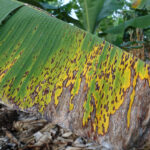New unreported papaya disease identified in Ecuador

Ecuadorian scientist Diego Quito Ávila has identified a new virus in papaya plantations that had not yet been reported internationally, through the process of plant virology. As part of the Prometheus Project (Proyecto Prometeo in Spanish), a government initiative, he has been working closely with commercial growers to determine how this new virus affects production.
"According to the information obtained up until now, the genome of this virus involves a new species," the scientist told www.freshfruitportal.com. 
"There is no record of this virus in global databases for any crop. There are viruses in other crops that are distantly related at a genomic level to this new species.
"So far, we have detected the virus in commercial papaya plantations in the provinces of Ecuador. Its presence is not known in other regions of the world."
Quito Ávila, who is in charge of plant virology at the Ecuadorian Center for Biotechnological Research (CIBE), explained the virus was found by extracting double-stranded RNA (ssRNA) viruses from plants that arrived at the lab for analysis of papaya ringspot virus (PRSV), which is present globally and is of greater economic significance to the trade.
"We noted that, besides the presence of PRSV, there was a band of ssRNA of a different size to what's expected for PRSV," he said.
"We decided to sequence this band and that's how we discovered it had to do with a new virus," said Quito Ávila, who added the RNA has a simple chain, phylogenetically related to members of the genus umbravirus, with a genome of between 4-5kb.
"The form of transmission has not yet been determined, nor has it been determined if it cuases symptoms in the plant," he said, adding that this represented a risk for growers.
He added studies were underway to find out how the virus spread in the field, the implications for symptoms, and whether it interacted with PRSV to cause severe symptoms.
"Once we verify what negative impact this virus has on papaya production, we hope to be able to determine how to manage and prevent the presence of this virus in commercial plantations in a more efficient way," Quito Ávila said.
"So far, we cannot assert what the risk of the presence of this virus in papayas is. We are working to find out this and other epidemiological aspects of this virus, and therefore, growers ought not be alarmed until we know more about this virus."
Studies in other fruits
In addition to the research project with papayas, Quito Ávila is also working with other emblematic fruits from Ecuador, including melons, watermelons and tamarillos.
"In melons, watermelons and cucumber we have detected and reported the melon yellow spot virus (MYSV) for the first time in Ecuador, in the region. This virus was detected for the first time in Japan, and until recently it had only been reported in some Asian countries.
He said MYSV was transmitted via thrips insects, mostly in the coastal areas of Ecuador where the pest had been observed more in recent years.
"The importance of including MYSV in routine analysis in our region is of vital importance, as combined with other viruses they could result in great economic losses."
In terms of tomatillos, in research together with the National Agricultural Research Institution, the scientist said at least three potyviruses had been found, which were currently under investigation to determine their importance and role.
"We suspect the presence of additional viruses in this crop, and we are working on determining whether it involves something new," he said.
"Additionally, for the first time in Ecuador we reported the raspberry bushy dwarf virus (RBDV) in commercial Castilla raspberry (Rubus glaucus) crops."
He highlighted this was one of the most common viruses in blackberries and raspberries globally, however Ecuador has had no prior record of its presence.
"The isolation of RBDV in Ecuador has a special characteristic at the genomic level which distinguishes it from the isolations reported in other parts of the world.
"The function of this characteristic in etiological terms in berry diseases is still unknown."
Prometheus Project
Quito Ávila's work with the Prometheus Project began at the start of 2012, with various efforts taking place to identify plant viruses.
"This year, thanks to funds provided by the International Foundation for Science (IFS), we have been exploring viral diversity in plants native to the Galapagos Islands," he said.
In the scientist's opinion, Ecuador is a bit delayed when it comes to researching fruit diseases.
"The Government has triggered the development of research projectings over recent years, and the results are starting to be seen. In terms of detection and identifying viruses, we are moving at a good pace and we hope that very soon, it will be a reference at the regional level for basic and applied research in this area."







































